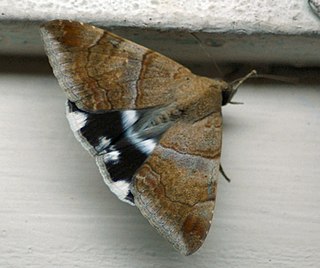
Achaea janata, the castor semi-looper or croton caterpillar, is an erebid moth, the caterpillars of which are termed 'semi-loopers' due to their mode of locomotion. It is found from the Indo-Australian tropics and subtropics, extending south to New Zealand and east through the Pacific archipelagoes to Easter Island. It is a major pest of castor throughout the world.

Amyna is a genus of moths of the family Noctuidae erected by Achille Guenée in 1852.
Dactyloplusia is a monotypic moth genus of the family Noctuidae erected by Chou Io and Lu Chinsheng in 1979. Its single species, Dactyloplusia impulsa, was first described by Francis Walker in 1865. It is found in Sri Lanka, India, southern China, Sundaland, Sulawesi, New Guinea, Fiji and Australia.

Dordura is a monotypic moth genus of the family Noctuidae erected by Frederic Moore in 1882. Its only species, Dordura aliena, was first described by Francis Walker in 1865. It is found in the Indian subregion, Sri Lanka, Myanmar, Thailand, Peninsular Malaysia, Sumatra, Borneo and New Guinea.
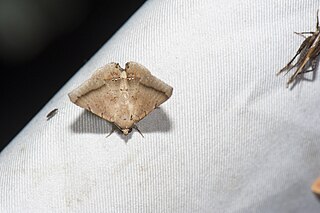
Macaldenia palumba is a moth of the family Noctuidae first described by Achille Guenée in 1852. It is found from the Oriental region of India, Sri Lanka to Japan (Okinawa) and Sundaland, east to New Guinea. It is also found on Guam in Micronesia.

Eudocima phalonia, the common fruit-piercing moth, is a fruit piercing moth of the family Erebidae. The species was first described by Carl Linnaeus in his 1763 Centuria Insectorum. It is found in large parts of the tropics, mainly in Asia, Africa and Australia but introduced into other areas such as Hawaii, New Zealand and the Society Islands. It is one of major fruit pests in the world.

Ctenoplusia limbirena, the Scar Bank gem, or silver U-tail, is a moth of the family Noctuidae. It is found in south-western Europe, Africa, the Canary Islands, Arabia, the southern Himalayas, India, Sri Lanka, Indochina to south-eastern China, Taiwan, Sulawesi, Bali and Timor. In New Zealand, it has been established since 2011.

Sympis rufibasis is a moth of the family Noctuidae first described by Achille Guenée in 1852. It is found from the Indo-Australian tropics of India, Sri Lanka, Borneo east to New Guinea, the Solomons and Queensland.
Trichoplusia lectula is a moth of the family Noctuidae first described by Francis Walker in 1858. It is found throughout Asia, including the Indian subregion, Sri Lanka, Thailand, Borneo, Java, Japan, as well as Western Australia and Queensland.
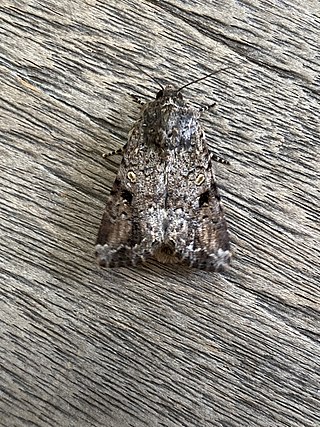
Spodoptera mauritia, the lawn armyworm or paddy swarming caterpillar, is a moth of the family Noctuidae. The species was first described by Jean Baptiste Boisduval in 1833. Able to eat many types of food, it is a major pest throughout the world.

Penicillaria jocosatrix, the mango shoot borer, is a moth of the family Euteliidae first described by Achille Guenée in 1852. It is found from southeast Asia to the Pacific. Records include Borneo, Guam, Hawaii, India, Sri Lanka, Thailand and in Australia, Western Australia, the Northern Territory and Queensland.

Tiracola plagiata, the cacao armyworm, is a species of moth in the family Noctuidae. The species was first described by Francis Walker in 1857. It is found from south-east Asia, southern India, Sri Lanka, Myanmar to the South Pacific Islands, including the northern two-thirds of Australia.

Oraesia emarginata is a species of moth of the family Erebidae first described by Johan Christian Fabricius in 1794. It is found in Australia, New Caledonia, Indonesia, New Guinea, Pakistan, the Philippines, India, Sri Lanka, Sulawesi, Taiwan, China, Japan, Korea and Nepal as well as Eritrea, Ethiopia, Kenya, Namibia, Nigeria, South Africa, Tanzania, the Gambia, Uganda, Oman and Yemen.
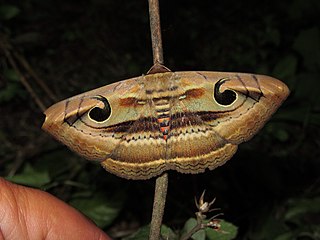
Spirama retorta, the Indian owlet-moth, is a moth of the family Erebidae. The species was first described by Carl Alexander Clerck in 1764. It is found in China, Korea, Japan (Honshu), India, Nepal, Bangladesh, Thailand, Cambodia, Myanmar, Vietnam, Taiwan, Sri Lanka, Malaysia, the Philippines (Luzon), Indonesia ,Japan.

Amyna punctum is a moth of the family Noctuidae first described by Johan Christian Fabricius in 1794. This moth can be found throughout subtropical African countries such as South Africa, Madagascar and Australasian countries like India, Sri Lanka, the Philippines, Borneo and the Andaman Islands.
Ziridava xylinaria, the indistinct carpet, is a moth in the family Geometridae. The species was first described by Francis Walker in 1863. It is found in Sri Lanka, India, Hong Kong and on Peninsular Malaysia, Borneo, Java and possibly the Philippines and Sulawesi.
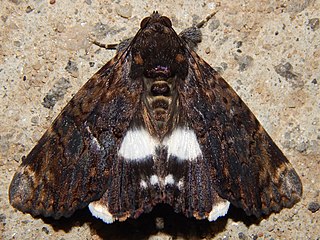
Nagia linteola is a species of moth in the family Erebidae first described by Achille Guenée in 1852. This species occurs in South Africa, the Democratic Republic of the Congo, Yemen, the Comoros, Mauritius, Madagascar, Indonesia (Borneo), India, Sri Lanka, Myanmar, Thailand and in Australia, where it has been recorded from Western Australia, the Northern Territory, Queensland and Victoria.
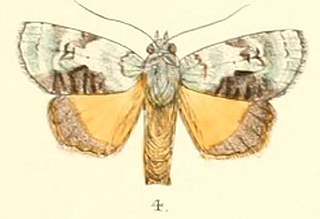
Blenina donans is a moth of the family Nolidae first described by Francis Walker in 1858. It is found from India, Sri Lanka to the Pacific region.

Athetis reclusa is a moth of the family Noctuidae first described by Francis Walker in 1862. It is found from Sundaland to New Caledonia and Fiji. The habitat consists of open areas from sea level up to 1,200 meters.
Episparis liturata is a moth of the family Noctuidae first described by George Hampson in 1893. It is found in India, Sri Lanka, Java, Borneo, Myanmar, China and Thailand.
















